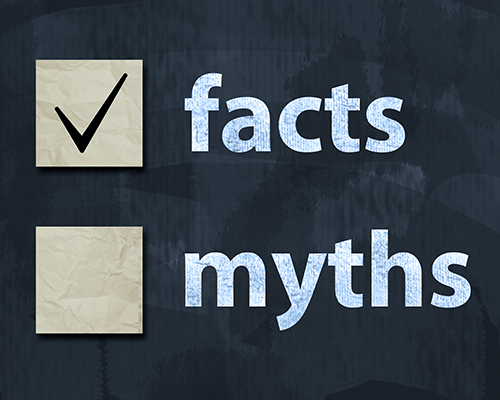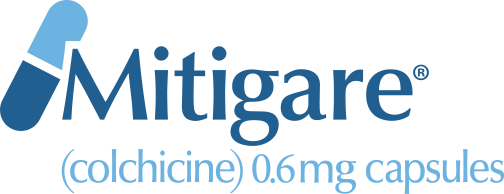
Gout was first identified by the Egyptians in 2640 BC.1 However, many misconceptions about the disease have developed since then. How much do you know about gout? In this article, we will review some gout myths and reveal some truths surrounding this potentially debilitating disease.
Gout Myth #1: Gout always starts in the big toe
Although gout often strikes first in the big toe, it can occur in any joint.2 Other areas commonly affected include the ankles, knees, elbows, wrists and fingers.2 Women are slightly less likely than men to experience gout in the big toe first.3
Gout Myth #2: Only men are affected by gout
Gout affects more than eight million people in the US.4 It is true the vast majority of those who suffer with the disease are men.4 However, gout can affect women as well.4 Approximately one out of every four gout sufferers is female.4
Gout Myth #3: Gout is caused mainly by what you eat and drink
Gout was believed for years to be a “rich man’s disease,” primarily caused by overindulgence in food and drink.5 However, recent research has demonstrated that this may not necessarily be the case.6,7 Recent studies conducted in Japan and Taiwan have suggested that although diet can affect gout risk, heredity may be likely to blame.6,7 It is important to note, however, that certain foods and beverages (such as red meat, shellfish and alcoholic or sugary drinks) may trigger flares in some people already diagnosed with gout.4
Gout Myth #4: No one really gets gout anymore
The incidence of gout in the US has more than doubled over the past 20 years.8 This may be because the 65-and-over age group is growing faster than any other segment of the US population9, and your risk of gout rises as you age.10 Diet and lifestyle could also be driving this trend.11
Gout Myth #5: Gout goes away between attacks
Although they may feel like they last forever, most people with gout know that gout flares do eventually subside.4 What many people do not know, however, is that the cause of the disease—high uric acid levels—must be managed with (ULT; a kind of medicine that helps to reduce the amount of uric acid in the bloodstream) or other treatment.12 If gout is ignored, urate crystals can continue to build up in the joint(s), silently preparing for the next attack.4
Gout Myth #6: Once you develop gout, you’ll always have it
According to the Harvard Health Letter, gout is treatable and even curable.12 To help manage the disease, many people with gout are prescribed ULTs.12 Some adults are also prescribed a medicine that can prevent gout flares, such as Mitigare® (Colchicine) 0.6 mg capsules or Generic Colchicine Capsules.13 The safety and effectiveness of Mitigare for acute treatment of gout flares during prophylaxis has not been studied. Mitigare is not an analgesic medication and should not be used to treat pain from other causes. The most commonly reported adverse reactions with colchicine are gastrointestinal symptoms, including diarrhea, nausea, vomiting and abdominal pain.
Talk with your doctor
If you think you might have gout, make an appointment to see your doctor. You may also want to download and complete the Gout Flare Questionnaire (from resources for patients) in advance of your appointment. But don’t wait—unless it is managed, gout can result in permanent bone, joint and tissue damage.14 Gout has also been linked to other health issues including kidney disease, diabetes, heart attack and stroke.14
Important Safety Information
Colchicine 0.6 mg capsules are contraindicated in patients with renal or hepatic impairment who are currently prescribed drugs that inhibit both P-gp and CYP3A4. Combining these dual inhibitors with colchicine in patients with renal or hepatic impairment has resulted in life-threatening or fatal colchicine toxicity. Patients with both renal and hepatic impairment should not be given Mitigare®.
Fatal overdoses have been reported with colchicine in adults and children. Keep Mitigare® out of the reach of children.
Blood dyscrasias such as myelosuppression, leukopenia, granulocytopenia, thrombocytopenia, and aplastic anemia have been reported with colchicine used in therapeutic doses.
Monitor for toxicity and if present consider temporary interruption or discontinuation of colchicine.
Drug interaction with dual P-gp and CYP3A4 inhibitors: Co-administration of colchicine with dual P-gp and CYP3A4 inhibitors has resulted in life-threatening interactions and death.
Neuromuscular toxicity and rhabdomyolysis may occur with chronic treatment with colchicine in therapeutic doses, especially in combination with other drugs known to cause this effect. Patients with impaired renal function and elderly patients (including those with normal renal and hepatic function) are at increased risk. Consider temporary interruption or discontinuation of Mitigare®.
Please see the full Prescribing Information and Medication Guide for Mitigare® for complete product details.
NOTE: This article was not written by a medical professional and is not intended to substitute for the guidance of a physician. These are not Hikma’s recommendations for gout flare prevention, but rather facts and data collected from various reliable medical sources. For a full list of resources and their attributing links, see below.
